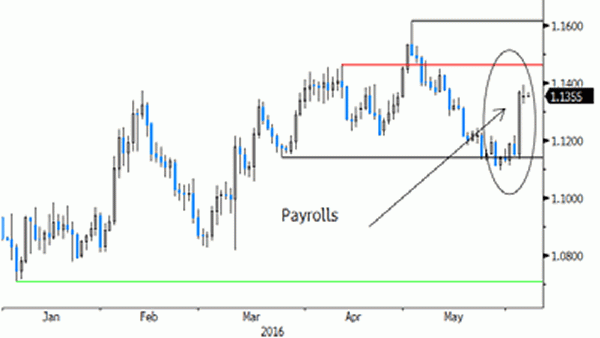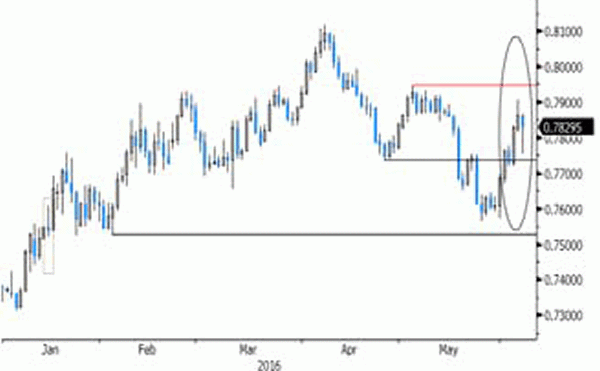Rates: Yellen ‘confirms’ the Fed won’t change policy in June and likely neither in July
Today’s calendar is uninspiring, but the German 10‐year yield is irresistibly close to the all‐time lows, while the US 10‐year yield approaches again the 1.70% support area. We are no fan of Bunds at such lofty levels. In the US, markets will still be occupied by guessing the timing of the next rate hike. After Yellen, also the July meeting has become less likely.
Currencies: dollar stabilizes as Yellen stays muted on timing of next rate hike
The dollar stabilizes after the post‐payrolls’ sell‐off. Yellen indicated further gradual normalization, but it was not enough to give the dollar a real boost. Today, technical trading might be on the cards. We look out whether EUR/USD tops out after the recent rebound. Sterling is also better bid as new polls suggest a narrow lead for the “Remain’ camp
The Sunrise Headlines
- US equities ended with moderate gains yesterday, supported by the Yellen comments. The S&P jumped to its highest level for this year. This morning, Asian shares show broad‐based gains.
- Fed Chairwoman Yellen signalled yesterday the Fed won’t raise rates next week, pointing to sizable uncertainties, which should be resolved first. Yellen however added that she expects the economic expansion to continue, reaffirming that the federal funds rate will need to rise gradually over time.
- Hillary Clinton secured the delegates needed to clinch the Democratic nomination, according to the Associated Press, just one day ahead of the primaries in California and five other states.
- The Reserve Bank of Australia left interest rates unchanged at its record low level of 1.75% as it judged policy is consistent with sustainable growth in the economy and inflation returning to target over time. The Aussie dollar strengthened further this morning.
- Two polls showed this morning that Britons narrowly favour remaining in the EU. According to the YouGov survey, the “remain’ camp rose by 2 points to 43%, overtaking the “Leave’ side which dropped to 42%. The ORB telephone survey showed the lead of the “Remain’ camp slowing to just one point.
- Today, the eco calendar remains thin with only the final reading of euro zone first quarter GDP. ECB’s Makuch and Knot are scheduled to speak.
Currencies: Dollar Stabilizes As Yellen Stays Muted On Timing Of Next Rate Hike
Dollar stabilzes as Yellen confirms slow rate hike path
On Monday, the dollar held tight ranges against the euro and the yen close to the post‐payrolls lows as investors awaited a speech from Fed chairwoman Yellen. She indicated to remain confident that positive forces will support employment growth and inflation. So further gradual increases in the Fed fund rate are likely. Yellen mentioned several risks including Brexit. Contrary to last week (“in coming months’), the Fed chair didn’t give any hints on the timing of a next rate hike. The dollar spiked temporary up and down during Yellen’s speech, but finally returned to the intraday trading range. EUR/USD closed the session at 1.1355, little changed from the 1.1367 close on Friday. USD/JPY regained some ground as equities performed rather well. The pair closed the session at 107.56, up from 106.53 on Friday.
Overnight, Asian equities trade in positive territory. The prospect that US interest rates will be raised only very gradually supports equities and keeps commodities well bid. Japanese equities reversed the post‐payrolls losses. USD/JPY also rebounds. The pair trades in the 107.85 area. Other Asian markets also show gains of about 0.5%‐1%, with China underperforming. The RBA as expected left tis policy rate unchanged at 1.75%. The RBA said the decision is consistent with sustainable growth and CPI returning to target even as inflation will remain quite low short‐term. Of late, the Aussie dollar was already supported by the positive sentiment on global commodity markets. AUD/USD extends gains after the RBA decision and jumped north of AUD/USD 0.74. EUR/USD continues yesterday’s trading pattern and holds a sideways trading pattern in the mid 1.13 area.
The eco calendar is again thin today. In Europe, the final EMU Q1 GDP will be published. EMU growth is expected to be confirmed at 0.5% Q/Q and 1.5% Y/Y. Investors will keep an eye at the composition of the growth, but we don’t expect the report to have a lasting impact on EUR/USD trading. In the US only the final Q1 until labour cost and productivity data will be published. Yellen mentioned productivity growth as a risk in her speech yesterday. However, we don’t expect today’s finial productivity data to move currency markets. So, USD trading will be technical in nature. We look out whether there is some post‐Yellen repositioning. For now, markets don’t look inclined to prepare for Fed action anytime soon. At the same time, the constructive equity sentiment should help to protect the downside of the dollar. We stay cautious on USD/JPY in a longer term perspective. Short‐term, the 106.38/105.55 support looks quite solid. The dollar still trades a bit weak against the euro. However, with the Fed still on track to raise rates over time and the euro potentially feeling headwinds from all kinds of event risk (including Brexit), we look out for a short term topping out process in EUR/USD.
Technically, the dollar rebounded in May on more hawkish Fed comments/Minutes that opened the door for a possible June rate hike. Our basic scenario was (and still is) that the US economy is strong enough to allow the Fed to implement two rate hikes this year. However Friday’s payrolls triggered a repositioning in the dollar. The break/test of the EUR/USD 1.1217/1.1144 area is rejected. We assume some consolidation in EUR/USD as markets will look for other key US eco data to assess the timing of the next Fed rate hike. Brexit might also become a wildcard for EUR/USD trading. A global USD rally blocked the downside of USD/JPY early May. The pair started a steady rebound. The high 111 area was a strong resistance, but a real test didn’t occur. The pair was already off the recent highs before the payrolls and the decline accelerated after the release. With the Fed rate hike probability declining and global sentiment potentially weakening, we expect any rebound of USD/JPY to be short‐lived.
EUR/USD: rebound to run into resistance?
Sterling sell-off slows, for now
On Monday morning EUR/GBP extended its rally. On Friday, the move was inspired by the post‐Payrolls rally of EUR/USD. Yesterday morning, the move was due to outright sterling weakness as two opinion polls indicated a lead of the leave‐camp over the remain‐camp for the June 23 UK referendum. EUR/GBP touched offers just north of 0.79 in Asia. Cable dropped temporary below the 1.44 area. During the European session, there were no additional sterling losses even as the Brexit topic was in the spotlights on the financial newswires. The rebound of UK/commodity stocks maybe helped to avoid further sterling losses. EUR/GBP closed the session at 0.7861 (from 0.7829 on Friday). Cable finished the day at 1.4442 (from 1.4518 on Friday).
This morning, sterling trades very volatile. BRC like for like sales were stronger than expected at 0.5 Y/Y (from ‐0.9% Y/Y).Contrary to polls in the weekend indicating a lead for the Brexit‐camp, two new polls this morning show a narrow lead for remain. However, other factors were probably also in play given the very wild swings (fat finger?). In the end, sterling trades again slightly stronger to yesterday’s close. Later today, the Halifax house prices will be published, but we assume that Brexit will remain the key driver for sterling trading. Yesterday’s tensions apparently eased this morning. Even so, we expect sterling to remain in the defensive as the campaign on the EU referendum intensifies. The break above 0.7750 is a first indication of further deteriorating sterling sentiment. We maintain a sterling negative bias
EUR/GBP: sterling decline slows, for now















